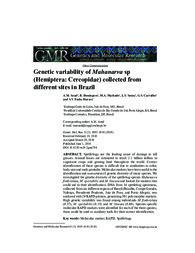Genetic variability of Mahanarva sp (Hemiptera: Cercopidae) collected from different sites in Brazil.
Genetic variability of Mahanarva sp (Hemiptera: Cercopidae) collected from different sites in Brazil.
Author(s): AUAD, A. M.; DOMINGUES, R.; MACHADO, M. A.; SOUZA, L. S.; CARVALHO, G. S.; MORAES, S. V. de P.
Summary: Spittlebugs are the leading cause of damage to tall grasses. Annual losses are estimated to reach 2.1 billion dollars in sugarcane crops and grazing land throughout the world. Correct identification of these species is difficult due to similarities in color, body size and male genitalia. Molecular markers have been useful in the identification and assessment of genetic diversity of many species. We investigated the genetic diversity of the spittlebug species Mahanarva fimbriolata, M. spectabilis and M. liturata and looked for markers that could aid in their identification. DNA from 34 spittlebug specimens, collected from six different regions of Brazil (Brasília, Campo Grande, Valença, Presidente Prudente, Juiz de Fora, and Porto Alegre), was analyzed with 29 RAPD primers, generating 501 polymorphic markers. High genetic variability was found among individuals M. fimbriolata (0.37), M. spectabilis (0.18) and M. liturata (0.69). Species-specific molecular RAPD markers were identified for each of the three species; these could be used as auxiliary tools for their correct identification.
Publication year: 2010
Types of publication: Journal article
Unit: Embrapa Dairy Cattle
Keywords: Molecular marker, RAPD, Spittlebugs
Observation
Some of Embrapa's publications are published as ePub files. To read them, use or download one of the following free software options to your computer or mobile device. Android: Google Play Books; IOS: iBooks; Windows and Linux: Calibre.
Access other publications
Access the Agricultural Research Database (BDPA) to consult Embrapa's full library collection and records.
Visit Embrapa Bookstore to purchase books and other publications sold by Embrapa.

